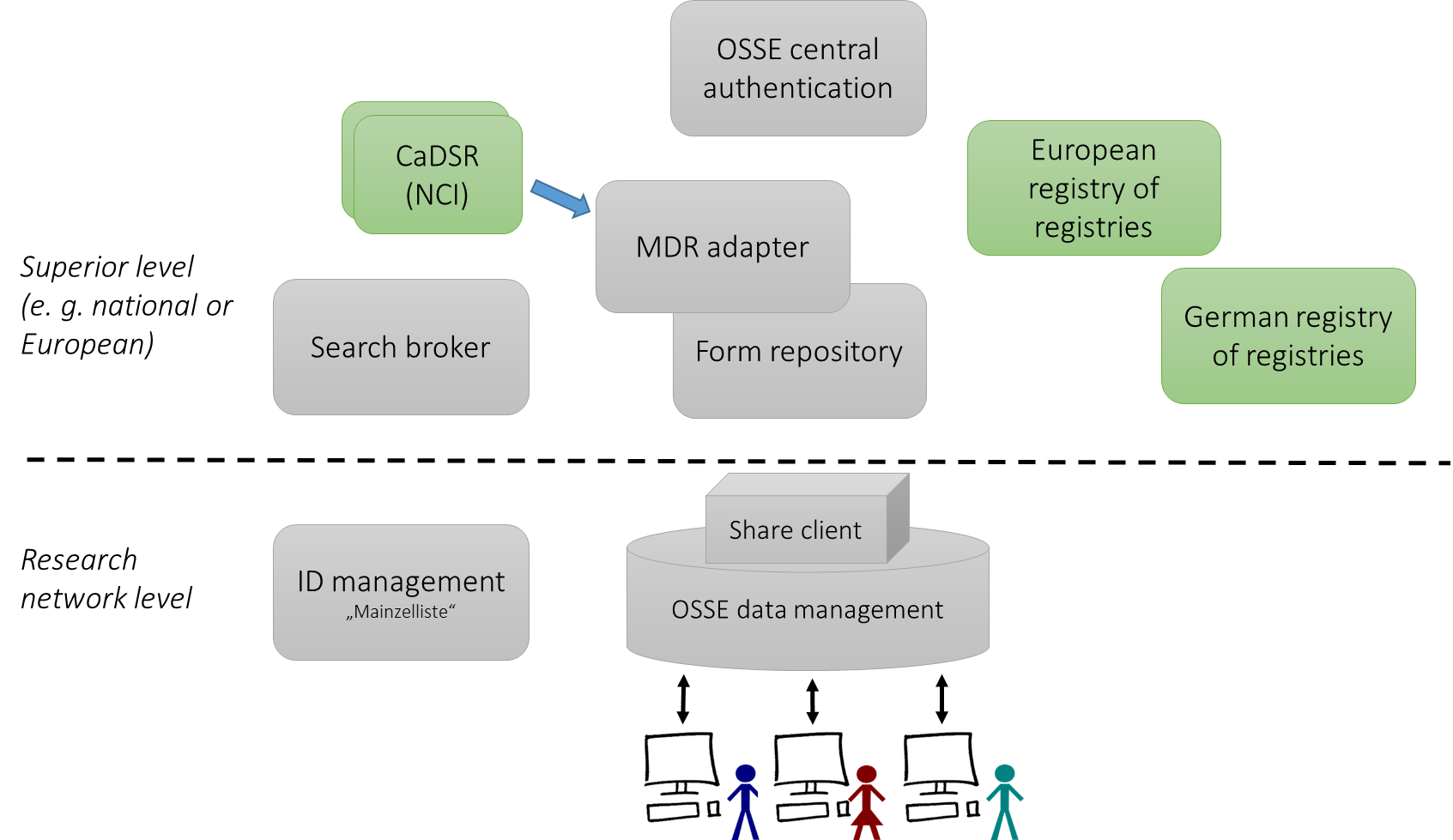Wiki
Clone wikisamply.edc.osse / Home
OSSE for Software Developers - Getting Started
In the following, we give you a short overview of how to navigate the various OSSE subprojects. Please be sure to visit each subproject for detailled instructions.
##1 About OSSE##
The OSSE registry framework is a toolbox that supports the setup of disease-related registries in the area of rare diseases. The framework consists of several local components that each registry compound runs by itself and central components that are operated for several (ideally all) OSSE-type registries.

Figure: Components of the OSSE registry framework (grey) and systems that are interfaced (green)
Local Components
Each registry compound runs an OSSE data management component for the recording and storage of patient data and a share client component with which the registry can participate in the decentral search1, a federation used to respond to cross-registry inquiries while preserving each data owners' sovereignty. The share client also provides a data export interface. Generally, each compound also operates its own identity management for the pseudonymization of documented patients according to data protection rules. This could, for example, involve one instance of the Mainzelliste2, which can be operated by a trusted third party to achieve informational separation of powers.
Central Components
The metadata repository (MDR) serves the purpose of harmonizing data elements, i.e. the precise definition of the meaning of data recorded in a registry. It is operated in combination with the form repository which is used to define and store forms. Preferably, MDR and form repository are operated in tandem for all OSSE registries in order to achieve a high degree of data comparability. The OSSE MDR adapter can be used as a standalone MDR, but it also has interfaces to e.g. the TMF e.V. metadata repository and the National Cancer Institute's caDSR allowing to re-use and interlink data elements.
The search broker is a centrally operated component for inquiries. OSSE-based registries or bridgeheads may register with this search broker to participate in the "decentral search".
The central authentication enables components to interoperate without handling credentials for each user of the OSSE data management. It implements the OAuth 2.0 protocol.
Registries of Registries
The OSSE data management supports a registry's reporting to various registries of registries such as the TMF German national registry portal and the European Registry of Registries for Rare Diseases. Thus, basic information on the registry such as its name, goals, inclusion and exclusion criteria to describe the patient collective, etc. is recorded and displayed in a kind of public "showcase".
##2 Open Source Projects related to the OSSE Components##
The technological foundation for OSSE (and several other projects) is called Samply. Thus, most components are named Samply [dot] [function]. In the first open source code release (v1.1) we provide source code for all local components:
OSSE Data Management
OSSE Networking and Federation
Common Projects containing Functions shared by various Components
- samply.auth.dto
- samply.common.mdrclient
- samply.common.mdrfaces
- samply.common.static
- samply.common.config
Identity Management Mainzelliste
We have prepared a Maven project to ease the checkout and build process: https://bitbucket.org/medinfo_mainz/samply.maven
For more details please see the Readme.md file in each source project and the information documents provided at the OSSE homepage http://osse-register.de.
-
Lablans M, Kadioglu D, Muscholl M, Ückert F. Preserving the owner’s autonomy in networks of patient registries and biobanks. Orphanet J Rare Dis. 2014;9(Suppl 1):P3. Available online ↩
-
Lablans M, Borg A, Ückert F. A RESTful interface to pseudonymization services in modern web applications. BMC Med Inform Decis Mak. 2015 Feb 7;15(1):2. Available online ↩
Updated